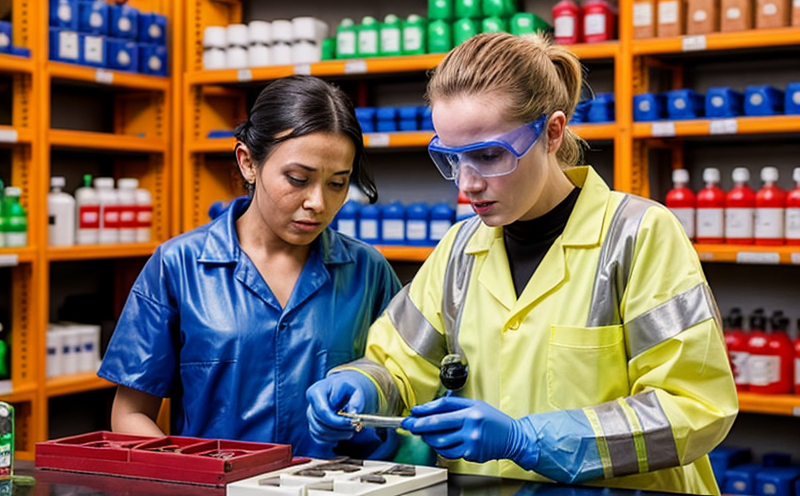Chemical & Hazardous Substances Testing for Trade
In government and trade facilitation testing, chemical and hazardous substances play a crucial role in ensuring that products meet international standards and regulations. This service is pivotal for quality managers, compliance officers, R&D engineers, and procurement teams who need to ensure the safety and integrity of goods as they traverse borders.
Chemical & Hazardous Substances Testing for Trade involves analyzing materials and substances present within a product or its packaging to identify potential risks associated with their chemical composition. This testing ensures that all chemicals used are compliant with international standards such as REACH (Registration, Evaluation, Authorisation, and Restriction of Chemicals) in the EU and TSCA (Toxic Substances Control Act) in the USA.
The process begins by collecting samples from various stages of production or import. These samples undergo rigorous analysis using advanced techniques like GCMS (Gas Chromatography-Mass Spectrometry), HPLC (High-Performance Liquid Chromatography), and ICP-OES (Inductively Coupled Plasma Optical Emission Spectroscopy). Each technique offers unique insights into the chemical makeup of substances, enabling precise identification and quantification.
Following analysis, results are compared against established safety thresholds. Non-compliance can lead to significant issues such as trade embargoes or recalls, which can severely impact a company's reputation and financial stability. Therefore, accurate testing is not just essential but imperative for maintaining compliance with international regulations.
A key aspect of this service lies in understanding the broader context of chemical use within different industries. For instance, electronics manufacturers must adhere to specific limits on heavy metals like lead, mercury, cadmium, etc., while pharmaceutical companies need to ensure drug purity and stability through thorough testing. By offering comprehensive chemical analysis services tailored to these sectors, we provide a robust framework for compliance.
Our team of experienced chemists specializes in interpreting complex data sets generated during the testing process. They translate technical findings into actionable insights that help businesses make informed decisions about product development and market entry strategies. This expertise ensures that our clients stay ahead of regulatory changes and industry trends, thereby safeguarding their operations from potential disruptions.
In summary, Chemical & Hazardous Substances Testing for Trade is a critical component in ensuring the safe movement of goods across borders. Through precise analysis and interpretation supported by international standards like REACH, TSCA, and others, we empower our clients to meet regulatory requirements confidently while minimizing risks associated with chemical exposure.
Why It Matters
The importance of Chemical & Hazardous Substances Testing for Trade cannot be overstated. Non-compliance can result in severe consequences including legal penalties, reputational damage, and lost business opportunities due to trade restrictions or embargoes. On a global scale, such issues also affect supply chains and economic stability.
For quality managers, understanding the chemical content of products is essential for maintaining consistent product quality and ensuring that materials meet specified performance criteria. Compliance officers rely on this service to verify adherence to regulatory requirements, which helps protect against legal challenges and ensures business continuity.
R&D engineers benefit from detailed testing results as they can use these insights to innovate safer formulations while staying within permissible limits set by regulations. Procurement teams leverage our expertise in selecting suppliers who adhere strictly to international standards, thus reducing the risk of non-compliant materials entering their supply chains.
In essence, chemical & hazardous substances testing serves as a vital link between raw material selection and final product release, ensuring that each step along the way complies with relevant laws and guidelines. This comprehensive approach not only mitigates risks but also fosters trust among stakeholders involved in international trade.
Environmental and Sustainability Contributions
By identifying hazardous substances early in the manufacturing process, we help prevent pollution caused by improper disposal or release into the environment.
The reduction of harmful chemicals ensures a cleaner production cycle, supporting sustainable practices throughout supply chains.
Our rigorous testing processes contribute to minimizing waste generation and promoting resource efficiency within industries.
Through accurate identification and quantification, we aid companies in making informed choices that align with environmental protection goals.
Competitive Advantage and Market Impact
The ability to provide reliable chemical & hazardous substances testing for trade offers significant competitive advantages. Companies who can demonstrate strict adherence to international standards often gain an edge over competitors, especially in sectors where safety concerns are paramount.
By offering detailed reports on the composition of their products, businesses can build credibility with consumers and regulators alike. This transparency fosters trust among stakeholders, enhancing brand reputation and market position.
In addition, early identification of potential risks allows firms to proactively address issues before they escalate into full-blown crises. Such foresight not only protects against reputational harm but also prevents costly recalls or product withdrawals.
Moreover, compliance with regulatory requirements can open doors to new markets where stringent standards apply. By ensuring that all products meet these criteria, companies expand their reach and enhance their global competitiveness.
In conclusion, Chemical & Hazardous Substances Testing for Trade is more than just a compliance measure; it's an investment in long-term sustainability, trustworthiness, and market leadership.





